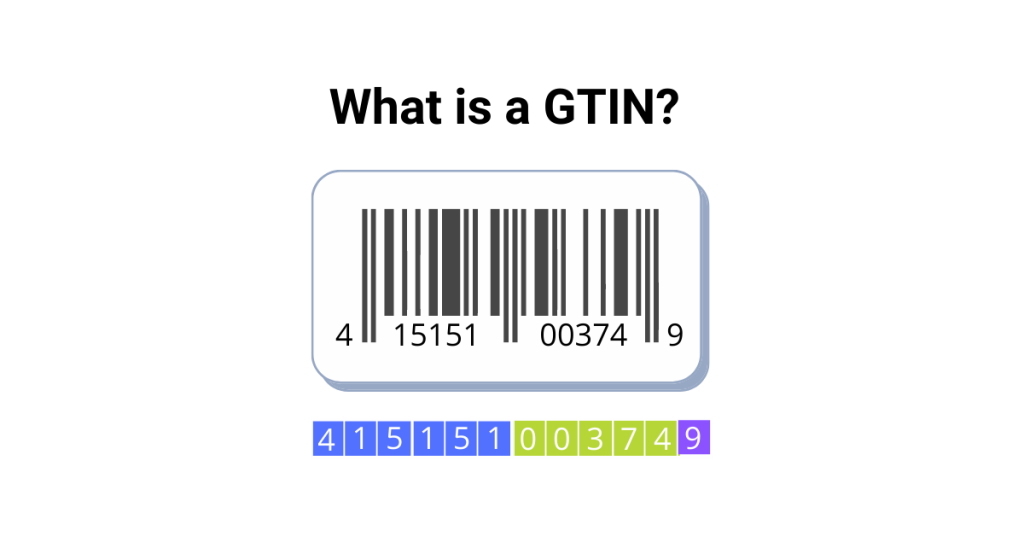
GTIN stands for Global Trade Item Number.
The Global Trade Item Number (GTIN) can be used by a company to uniquely identify all of its trade items. GS1 defines trade items as products or services that are priced, ordered or invoiced at any point in the supply chain. GS1 Global Registry holds information on who subscribed to trade items or party data using Global Location Numbers (GLN), Global Trade Identification Numbers (GTIN), Global Product Classifications (GPC), and Target Market (TM) as identifiers.
It can identify product types at any packaging level (e.g., consumer unit, inner pack, case, pallet, etc.) as it moves through the global value chain to the end user. If a product comes back into the value chain as a re-sold item or needs to be recalled, it can be re-identified by its original GTIN.
They are frequently encoded within a barcode, they can also be used on their own (some major online sellers use GTINs to authenticate a product before allowing it to be sold on their platform. It can be used to identify trade items online, for example in catalogs, in electronic messages such as purchase orders and invoices, and embedded in web pages to optimize use by search engines and other information consumers.
Benefits of using a GTIN
- Improved data quality
- Reduces confusion by accurately identifying specific products and avoiding duplicates
- Fights product counterfeiting
- Eliminates manual processing which saves time and resources
- Increases the efficiency of payment and reporting processes
- Provides a permanent record of products that can be leveraged when a product is resold or recalled
Types of GTINs
For Retail Point-of-Sale Products, only GTIN-12 and GTIN-13 are approved for retail point-of-sale applications.
GTIN-12s can be encoded with UPC-A and UPC-E barcode.
GTIN-13s can be encoded with the EAN-13 barcode.
For Logistic units (Inner packs, Cases and Pallets) consisting of a homogeneous grouping, you can use GTIN-14s or assign GTIN-12s or GTIN-13s.
GTIN-14s can only be encoded in barcode that have a 14-digit capacity. These include ITF-14, GS1-128, GS1 DataBar™, and Data Matrix.

GDSN Defined
The Global Data Synchronization Network (GDSN) is the world’s largest product data network.
GDSN makes it possible for any company, in any market, to share high-quality product information seamlessly. Because companies of all sizes need the same thing—timely and reliable product information—to ultimately benefit consumers and patients.
With GDSN, high-quality product content is uploaded, maintained, and shared automatically, ensuring trading partners have immediate access to the most current and complete information needed to exchange products on both local and global markets.
Conclusion
A Global Trade Item Number is a vital identifier in the world of commerce, facilitating unique product identification and smooth global trade. With its various formats, including GTIN-12, GTIN-13, and GTIN-14, businesses can enhance supply chain efficiency, reduce errors, and improve customer satisfaction by implementing standardized product identification through GTIN.
Frequently Asked Questions
Global Trade Item Number, is a unique identifier assigned to products to facilitate their identification in the supply chain. It is crucial for accurate and standardized product tracking, enabling efficient global trade and enhancing inventory management.
It come in different lengths. The most common ones are GTIN-12 (12 digits), GTIN-13 (13 digits), and GTIN-14 (14 digits). The length depends on the specific application and the GS1 system being used.
No, a GTIN is not the same as a barcode. It is the numerical component of the barcode and serves as a unique product identifier. Barcodes, on the other hand, are the graphical representation of the GTIN for scanning and data entry purposes.
It plays a crucial role in supply chain management by providing a standardized and globally recognized way to identify products. This facilitates accurate tracking, reduces errors, and enhances efficiency in logistics and inventory management.
They are designed to be unique to each product. Reusing GTINs for different products can lead to confusion in the supply chain and may cause errors in inventory management and order fulfillment. Each product should have its own distinct GTIN for accurate identification.





